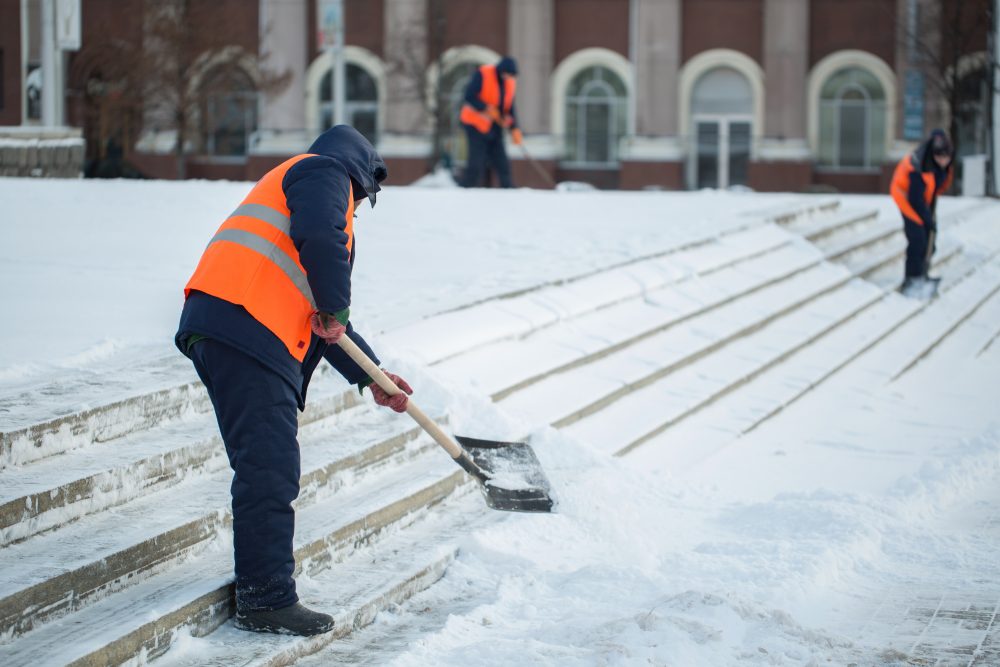
Winter is coming: Tips to prevent slips, trips and falls as the snow starts to fly
November 8, 2022
By
OHS Canada

For work in cold weather, employers need to do a cold-stress assessment and implement a plan to protect workers from cold exposure. (Artem/Adobe Stock)
Resist all you want, but snow is already falling in many parts of Canada. If it’s balmy where you are now, count your blessings — but prepare for the snow and ice to come.
SAFE Work Manitoba is reminding employers and workers of the increased risk of slips, trip and falls as we head into the slippery season. Sliding around isn’t just funny business either, as the agency pointed out some of the preventable injuries can be very serious.
Here are some steps employers can take to improve safety:
- ensure regular inspections of outdoor spaces to remove snow and ice
- use appropriate ice clearing practices
- use rubber mats in areas where the floors are regularly wet
- clean floors regularly and clean up puddles immediately (and mark the area to warn others)
- provide ice cleats for workers who work in snowy or icy conditions.
‘Unexpected’ change in contact
Slips and trips result from unintended or unexpected change in the contact between the feet and the ground or walking surface. Every year, slips, trips and falls cause thousands of workplace injuries. These range from minor cuts and bruises to those requiring long recovery times and time off work.
Statistics suggest that the majority of slip, trip and fall injuries reported to the Workers Compensation Board of Manitoba (WCB) result in time lost from work. In addition to lost workdays, injuries from slips trips and falls may result in reduced productivity, staffing shortages and potential WCB claims.
Slips may be caused by inconsistencies in walking surfaces, including standing substances such as ice, water, oil, loose gravel and worn-out flooring surfaces.
Trips start with a loss of balance and most often end in a fall. People may trip when a surface is uneven or another object gets in the way of a walking path. Common trip triggers include poor lighting, uneven carpet or flooring, cables or other electrical equipment, stairs and people not paying attention to the area where they are walking.
Most often, falls happen because of an unexpected change in conditions – that is surface conditions, environmental conditions or walking conditions.
Make it everyone’s responsibility to be part of the solution to fix slip, trip or fall hazards as soon as they notice them.
How to control the hazard
To protect everyone at the workplace, employers should:
- establish controls to eliminate or reduce people’s exposure to slip, trip and fall hazards
- provide information and instruction to people on slip, trip and fall hazards
- encourage people to report slip, trip and fall hazards
- identify and assess potential job-specific slip, trip and fall hazards
- provide measures to ensure the controls are working.
Potential controls to reduce or remove slip, trip and fall hazards:
- use rubber mats in areas where the floors are constantly wet
- clean floors regularly and clean up puddles or spills immediately (or mark the area to warn others)
- use slip-resistant waxes to polish and treat floors
- use contrasting colours to help people identify areas when walking conditions change. (e.g., paint a ledge bright yellow so people see the trip hazard)
- keep corridors and walkways clear of boxes and other clutter
- ensure corridors and walkways are well-lit as some people may need brighter lights to see slip-trip hazards
- secure loose rugs, mats, cables and cords
- ensure regular inspections of indoor and outdoor spaces to clear new hazards and/or climate dependent hazards such as ice and snow
- train people on proper use of ladders and stepstools.
If a hazard is spotted, people on site should:
- clean up any potential slip hazard and for large spills, barricade the area
- barricade trip hazards that cannot be easily repaired such as uneven areas
- contact housekeeping or facilities maintenance
- ask for non-slip tiling or other non-slip floor products to be installed, if possible.
Controls for reducing ongoing slip, trip and fall hazards include:
- keep filing cabinet or storage drawers closed
- secure all cords (workstation, computer etc.)
- wear appropriate footwear for the task being performed
- change into dry slip resistant footwear when you get inside on days that it’s raining or there is snow outside
- ensure you can see where you are stepping when you are carrying items
- use elevator when carrying large loads, take more trips or find help • be careful of curled edges or wet doormats and flooring.
- use a flashlight if you enter a dark room where there is no light.
Additional procedures
Ice is an additional slipping hazard during winter months. Inspect outdoor surfaces regularly for ice buildup, and use appropriate ice clearing practices. For individuals working outdoors in snowy or icy conditions, ice cleats may be an option for helping to reduce slips, trips and falls.
When on construction sites wear boots that rise above the ankle and are laced tight. Loose boots offer little support.
Source: WORK Safe Manitoba Bulletin 294: Slips, trips and falls.